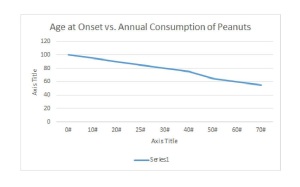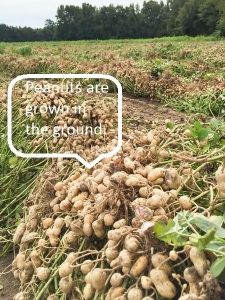Roland Hedley of Fox News reported today that researchers in the Department of Human Medicine at Michigan State University School of Animal Husbandry and Veterinary Sciences have determined that Alzheimer’s Disease is caused by eating peanuts. In a rigorous analysis of the dietary habits of more than 3,500 patients with Alzheimer’s Disease, they found that peanut consumption is inversely related to age of onset of Alzheimer’s. The higher the consumption of peanuts, the earlier the subjects in the study developed the disease. Those who never ate peanuts did not develop Alzheimer’s at all!
The cause of Alzheimer’s, it appears, is a fungus that grows inside the shell of all peanuts called trichophyton rubrum. Coincidentally, this is the same fungus that grows under toenails, causing dermatophytic onychomycosis or tinea unguium. Patients who chewed their toenails were at much higher risk of early-onset Alzheimer’s. Some toenail chewers developed Alzheimer’s as early as 16 to 18 years of age.
 The U.S. Food and Drug Administration has issued a controversial preliminary ruling that peanuts are a toxic substance that will be banned for human consumption. People for the Ethical Treatment of Animals has objected to the rule, demanding that it also ban animal consumption of peanuts.
The U.S. Food and Drug Administration has issued a controversial preliminary ruling that peanuts are a toxic substance that will be banned for human consumption. People for the Ethical Treatment of Animals has objected to the rule, demanding that it also ban animal consumption of peanuts.
The governor of Georgia, which is the nation’s number one producer of peanuts, also condemned the FDA’s action. The governor’s office released a statement that the 75-year-old governor had eaten massive quantities of peanuts all his life and had suffered no ill effects. “I’m no scientist,” Gov. John Deal proclaimed, “But I’ve eaten – What do you call those little beans that come in shells? – all my life and no government official is going to take my gun away from me. Georgia will secede from the union before it gives up its peaches.”
Pres. Barack Obama, who is known for serving peanut butter and jelly sandwiches at White House luncheons, stated that he is switching to Nutella to protect official guests. Ted Cruz, Republican candidate for president, said, “I’m no scientist, but if old people stopped eating peanuts there would be no problem.” Donald Trump, also a Republican candidate for president, stated, “I’m no scientist, but we need stop allowing diseased, criminal Mexican peanuts into this country.”
Contributed by Guest Blogger Moon Mullins
